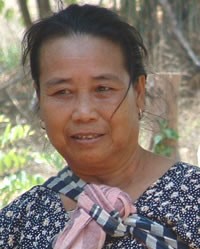So in Laos

Photo Source:
Ray Mason
|
Send Joshua Project a map of this people group.
|
| People Name: | So |
| Country: | Laos |
| 10/40 Window: | Yes |
| Population: | 93,000 |
| World Population: | 168,000 |
| Primary Language: | So (Laos) |
| Primary Religion: | Buddhism |
| Christian Adherents: | 1.42 % |
| Evangelicals: | 1.02 % |
| Scripture: | Portions |
| Ministry Resources: | No |
| Jesus Film: | No |
| Audio Recordings: | Yes |
| People Cluster: | Mon-Khmer |
| Affinity Bloc: | Southeast Asian Peoples |
| Progress Level: |
|
Introduction / History
The So live along both banks of the Mekong River in Thailand and Laos. This is a rugged mountain region with many dense tropical forests. The Lao-Thai name So ("elder brother") refers to the fact that the So were present in this area long before their "younger brothers," the Lao. The So are bilingual, speaking So (a Mon-Khmer language) in their homes and Lao in social settings.
It is said that the Mon Khmer-speaking tribes were the original settlers of this region. However, they were pushed out of the best lands in the early centuries A.D. by Thai-speaking peoples. About 400 years ago, Thai-speakers forced the So to leave their homes and re-settle on the banks of the Mekong River. They gradually adapted to the lifestyles of the Thai and the Lao. In recent years, Laos has been the location of numerous battles. It has also been the object of political competition among China, Russia and Vietnam.
What Are Their Lives Like?
The So of Laos are primarily farmers. They cultivate a wide variety of crops, such as rice, fruit, and vegetables, for both consumption and trade. They are poorer than most of the surrounding ethnic groups and are therefore dependent on the Lao for many goods and services. The villagers also frequently meet with the Thai to trade meat and vegetables for necessary items such as clothing and salt.
Over the years, the So began adopting the practices of the surrounding peoples, especially the Thai and Lao. This brought on many significant changes within their culture. For example, they no longer use their traditional farming methods of burning and clearing plots. Instead, they grow wet-rice on terraced plots, which is the agricultural method of the Thai. They also raise their cattle and till their fields much like the Lao. The fields are prepared with plows drawn by buffalo or oxen. In addition, fishing and hunting have become important activities.
Such things as traditional dress, language, educational methods, housing and public administration have also changed over the years. Only a few distinctive, cultural characteristics have remained, such as the silk scarves worn by the So women around a bun of hair at their necks.
Among the So, the village is considered the most significant political unit of society. Each village is led by a headman, and each family is led by the father. A young married couple may live with the bride's family until they are able to establish their own home. The So typically live in thatch roof bamboo houses built on stilts.
What Are Their Beliefs?
Buddhism was introduced into Thailand in 329 B.C.; and today, most of the So profess to be Buddhist. However, most of them have mixed elements of Buddhism with their traditional animistic beliefs (belief that non-living objects have spirits). That is especially true of the So people in Laos as compared with their counterparts in Thailand. They often seek help through supernatural spirits and objects. Ancestor worship (praying to deceased ancestors for provision and guidance) is also common. They believe ancestral spirits cause illnesses if they are not appeased. Families usually have small altars near their homes where they make sacrifices and offerings to the spirits. The people also believe that each village has a guardian spirit, as well as various spirits that are linked to the elements of nature.
There is a Christian minority among the So people especially in Laos.
What Are Their Needs?
The area where the So live is often affected by destructive floods. Many of the fields in this area are laden with cluster bomblets that were dropped by U.S. warplanes during Vietnam War. The villagers need God's protection as they work in the fields. They also need reliable medical facilities near their villages.
Prayer Points
Ask the Lord to call Christian medical teams to live among the So.
Pray that God will protect the So from the destructive floods in their region.
Pray for the small So church to reach out as salt and light to their neighbors.
Pray for the So people to have the spiritual hunger it takes to embrace Christ no matter what the cost.
Pray for the Holy Spirit to move mightily in So families, drawing entire clans to the Lord.